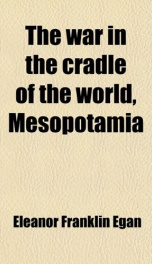the war in the cradle of the world mesopotamia

Purchase of this book includes free trial access to www.million-books.com where you can read more than a million books for free. This is an OCR edition with typos. Excerpt from book: CHAPTER IH THE BOMBAY SIDE OF THE PUNKA IT should have been cool in Bombay. It was not cool. I have set at the head of this chapter a phrase which is supposed to mean "cool," but it is a phrase which must have been invented by some one in a moment of derisive delirium induced by hot atmospheric pressure. It refers to the side of the punka opposite the ropes where the strongest and coolest breeze is to be enjoyed, but, so far as my experience goes, it suggests an absolutely false idea of the Bombay climate. It is said that the cool season is due in Bombay along in October. And this may be true. But I can testify that it makes its way in very cautiously and that in its earliest efforts it likes best to catch the stranger unawares along about three o'clock in the morning. In daytime it may haunt a few shady corners, but it is wholly imperceptible in any spot the sun touches. One's attention is sometimes called to curiously convincing evidence that the war has actually changed the climate in the hitherto temperate regions of the earth, but India is too far from the guns to get the benefit of any atmospheric disturbance they may create. However, while the physical discomfort of the white man in the brown man's land is not diminished, he thinks less about it than he formerly did. Toil and worry and sustained serious-mindedness have taken the place of leisure and fascinating frivolity, and non-essentials have faded for most persons into the unregarded background of life. This is true in some degree all over India; it is especially true in Bombay, which rose at the beginning of the war to pre-eminent importance as the chief base of the war zones of the East. The port of Bombay is the front door of India. Following the long coast-line round the tremendous peninsula, one d...
Info about the book
Author:
Series:
Unknown
ISBN:
1586485571
Rating:
4.5/5 (3)Your rating:
0/5
Languge:
English
Users who have this book
Users who want this book
What readers are saying
What do you think? Write your own comment on this book!
write a commentif you like the war in the cradle of the world mesopotamia try:
Other books by this author
Do you want to read a book that interests you? It’s EASY!
Create an account and send a request for reading to other users on the Webpage of the book!

